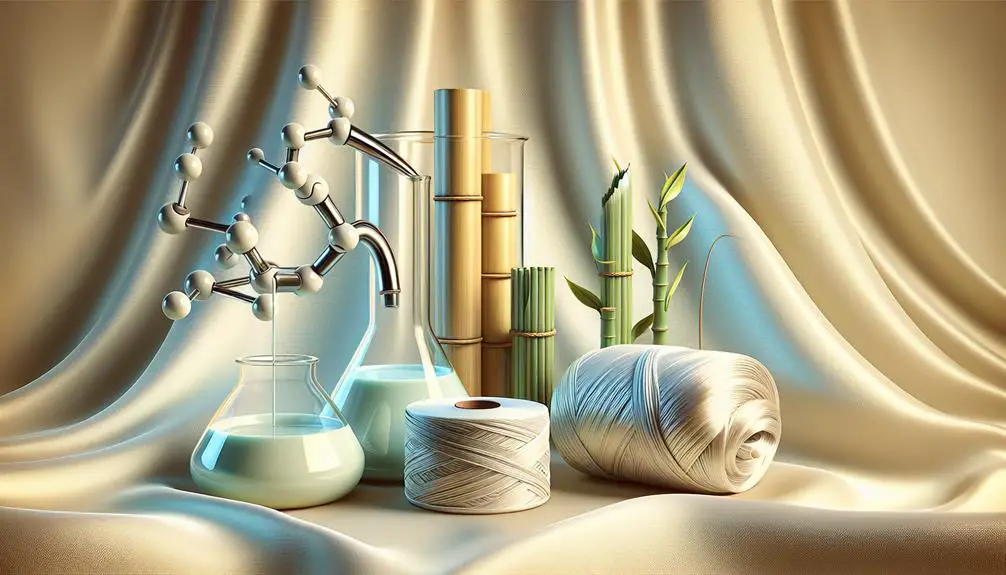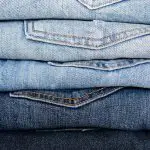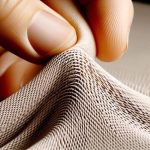So, I've been diving into the world of textiles lately, and I stumbled upon something pretty interesting about rayon. Did you know it's got a bunch of other names like artificial silk, viscose, and even something as quirky as art silk? It's fascinating how one fabric can disguise itself under so many aliases, each name shedding light on its synthetic yet luxurious nature. But here's the kicker – there's more to these names and what they reveal about rayon's history and its impact on fashion and sustainability. It makes me wonder, what stories are hidden behind these names?
Table of Contents
Key Takeaways
- Rayon is also known as artificial silk due to its silk-like feel.
- Another common name for rayon is viscose, widely used in the textile industry.
- Lyocell and modal are specific types of rayon with unique production methods.
- Historical terms for rayon include art silk and mother-in-law silk.
- Bamboo fabric is often considered a type of rayon because of its cellulose origin.
History of Rayon
Rayon burst onto the scene as the first synthetic fiber, offering a silk-like feel without the hefty price tag. It's fascinating how this material, made from regenerated cellulose, became an instant hit, especially when you think about its origins. I mean, here was a fabric that not only felt like silk but also was much more affordable. It was a game-changer.
What's really interesting is how rayon stepped up during the silk shortages in World War I and II. It wasn't just about fashion then; it was about necessity. The versatility of rayon made it indispensable, proving that it was more than just a silk substitute. It became a crucial material for parachutes, uniforms, and other military supplies.
The journey of rayon, from its humble beginnings to becoming a staple in the textile industry, is nothing short of remarkable. Its evolution over time, coupled with the fact that countries like China have become major players in both producing and consuming rayon, highlights its global impact. The fabric's history is a testament to human ingenuity in creating sustainable and affordable alternatives to luxury materials.
Manufacturing Processes
After exploring its rich history, let's now look at how manufacturers bring rayon from concept to closet. Essentially, rayon's journey from plant to fabric is a complex dance of chemistry and engineering. The starting point? Dissolving cellulose. Plants like wood pulp are the unsung heroes here, providing the cellulose that'll eventually transform into the cozy sweater in your wardrobe.
The process isn't simple; it requires a cocktail of chemicals, a significant amount of energy, and lots of water. This mixture works to dissolve the cellulose, creating a solution that can be extruded into fibers. These fibers are then spun into the threads that weave the soft, versatile fabric we know as rayon.
But here's the kicker: not all rayon is created equal. Viscose, modal, and lyocell each have their unique recipes and methods, tailored to produce different textures and properties in the final fabric. And while the chemical solvents involved can be nasty for both the environment and our health if mishandled, there's a silver lining. More manufacturers are leaning into sustainable practices, sourcing cellulose from forests that are managed with the future in mind, aiming to minimize our footprint on this planet.
Cuprammonium Method
Diving into the cuprammonium method, it's a less common but fascinating way to make rayon, producing silk-like fibers with a luxurious feel. This method takes cellulose and dissolves it in a special solution called cuprammonium. It sounds a bit science-y, and well, it is. But stick with me; it's not as complicated as it might seem. The key here is the solution used. Unlike other methods, cuprammonium rayon uses this unique mix to break down the cellulose into something that can be spun into fibers.
What's cool about cuprammonium rayon is the quality of the fiber it produces. We're talking finer, with a high luster that's similar to silk. This stuff has an excellent dye affinity, meaning it can take on vibrant colors really well, and it drapes beautifully. Think high-end fashion, the kind of material that flows and catches the light.
Sure, it's not as common as other types of rayon, but for anyone after that premium, silky feel in their textiles, cuprammonium rayon is a real gem. It's got a niche, but in the world of luxurious textiles, it's a star.
Viscose Method
So, let's talk about how rayon is made using the viscose method.
It's pretty interesting how they turn wood pulp into soft, breathable fabric through this process.
We'll also look at what goes into making it and how it impacts the environment.
Viscose Production Process
Let's explore how viscose rayon, known for its silk-like feel, is made through the viscose production process.
| Step | Description | Outcome |
|---|---|---|
| 1. Cellulose Dissolution | The process starts by dissolving cellulose in a chemical solution. | Creates a viscous liquid. |
| 2. Extrusion Through Spinnerets | This viscous solution is then pushed through spinnerets. | Fibers start to form. |
| 3. Solidification & Treatment | As fibers contact air, they solidify and are chemically treated. | Improves properties, removes impurities. |
| 4. Final Product | Resulting in viscose rayon fibers. | Known for softness, breathability, and draping qualities. |
It's a fascinating journey from cellulose to the versatile viscose rayon we use in so many aspects of our lives, from comfy clothes to stylish home textiles.
Raw Materials Used
The main ingredient in making viscose rayon is regenerated cellulose fibers, primarily sourced from wood pulp. Now, let's dive a bit deeper. Eucalyptus trees are often the go-to for this wood pulp, but it's not just about trees. We've got other players in the game too, like bamboo, soy, and even cotton. These are all fantastic sources for the cellulose needed to kickstart the viscose rayon production.
Here's the deal: producing viscose rayon isn't just about mixing stuff together. It involves a cocktail of chemicals, a whole lot of energy, and plenty of water to dissolve and regenerate those cellulose fibers into something wearable. And, while solvents in the mix can be a tad risky for us and the planet, it's all about striking that balance with sustainable practices.
Environmental Impact Analysis
How does the production of viscose rayon impact our planet? It's a mixed bag, honestly. On one hand, the process has its drawbacks, but on the other, there's a push towards more sustainable practices. Let's break it down:
- Deforestation: Thousands of hectares of trees are cut down annually for viscose rayon production, which isn't great for our planet.
- Chemical Use: The process uses harmful chemicals, leading to pollution. That's a big environmental no-no.
- Water Pollution: Effluents from production can wreck aquatic ecosystems. Not cool.
- Sustainable Shifts: Some manufacturers, like those making Lenzing Modal®, are going greener by using trees from sustainably harvested forests.
Lyocell Method
So, moving on from the viscose method, let's talk about the Lyocell method, which is kinda the eco-hero of the rayon family.
This process not only spares more trees but also uses way less water and chemicals, making it a greener choice.
Plus, it's interesting to see how its production compares environmentally to the older methods, right?
Lyocell Production Process
Lyocell's production process kicks off by dissolving wood pulp in a non-toxic solvent, marking a greener alternative in fabric manufacturing. This approach is a stark contrast to traditional rayon production, which often relies on harsh chemicals.
Let me break down why the lyocell method is worth your attention:
- Closed-loop system: Recycles almost all the solvent used, slashing waste.
- Energy and water efficient: Needs less of both than viscose rayon, easing its environmental footprint.
- Strong and soft fibers: These aren't just eco-friendly; they're top-notch in quality, offering durability and comfort.
- Biodegradable: The fibers are compostable, making them a friendlier choice for the planet.
In a nutshell, lyocell's making waves for good reasons, stepping up as a sustainable champ in the textile game.
Environmental Impact Comparison
When we compare the environmental impacts, it's clear that the Lyocell method stands out as the greener choice in rayon production.
Unlike traditional methods, Lyocell uses a closed-loop process. This means it recycles solvents, significantly cutting down chemical waste. It's a game-changer, really. We're talking less water, less energy, and therefore a much smaller environmental footprint.
Plus, the wood pulp? It comes from forests managed sustainably. That's peace of mind right there.
And when it's all said and done, Lyocell rayon doesn't stick around, adding to pollution. It's biodegradable.
Fiber Properties
Due to its versatility, rayon blends seamlessly with other fabrics, offering both comfort and a touch of luxury. Often referred to as artificial silk, rayon's got this lustrous appearance and soft feel that's hard to beat. It's like getting the best of both worlds: the glam of silk without draining your wallet.
Here's what makes rayon stand out:
- Mix and Match Magic: It plays well with others, like cotton, wool, and polyester, making it a team player in the fabric world.
- Cool and Comfy: Its moisture absorption is top-notch, which means wearing rayon in hot and sticky weather? Yes, please. You'll stay cool and dry.
- Versatile Vibes: Whether it's for chic clothing, cozy home textiles, or even in medical applications, rayon's drapability and breathability are a game-changer.
- Natural Mimicry: It can mimic natural fibers, especially silk, so well that it's become a go-to for a wide range of textile products.
Honestly, rayon's ability to offer this unique blend of practicality and luxury is what makes it such a standout in the textile industry.
Structural Modifications
Through tweaking its structure, rayon gets even better at what it does, from lasting longer to soaking up more moisture. It's all about playing with the building blocks of the fiber – that's the cellulose dissolved and reformed into filaments. By altering the molecular structure, we're not just talking minor improvements. We're seeing rayon that can stand up to more wear and tear, stretch without snapping back, and even behave differently under different conditions.
Now, how do they do it? It's a mix of science and a bit of magic. Cross-linking the cellulose molecules can make the fibers tougher. Imagine it's like adding a few extra bridges between islands, making the whole structure more robust. Then there's blending rayon with other fibers, which can be a game-changer for both durability and texture. And don't get me started on surface treatments – they can make rayon hydrophobic or super absorbent, depending on what's needed.
These structural mods are why rayon's not just a one-trick pony. It's versatile, adapting to needs across textiles, medical fields, and even industrial uses. It's all about customization, tailoring this wonder material precisely to what's needed.
Producers and Brands
Let's talk about who's making rayon and the brands leading the charge in its innovation. Big names like Lenzing AG and Aditya Birla Group are at the forefront, with Tencel and Ecovero setting the bar high for sustainability.
This shift towards eco-friendly production is reshaping how we think about rayon in fashion and beyond.
Leading Rayon Manufacturers
When it comes to rayon, manufacturers like Lenzing AG and Aditya Birla Group lead the pack, setting high standards for sustainability and innovation in the industry. It's fascinating to see how these companies aren't just about making fibers; they're reshaping what we expect from sustainable textiles.
Here's a quick rundown of the leaders:
- Lenzing AG – They're all about sustainable fibers like Tencel and Modal.
- Aditya Birla Group – A titan in the rayon market focusing on eco-friendly practices.
- Sateri – Prides itself on being one of the largest viscose producers, with a keen eye on sustainability.
- Fulida Group – A major player from China, catering to a vast market with their rayon fibers.
Each of these manufacturers is pushing the envelope, making me excited about the future of fashion and textiles.
Popular Brand Names
After highlighting the industry leaders in rayon manufacturing, we're now shifting our focus to the standout brand names and producers like Lenzing and Birla Cellulose that consumers should know.
Lenzing isn't just a name; it's a benchmark for sustainability, crafting fibers under the trade names Tencel and Modal. These aren't just labels; they're a promise of eco-friendly quality.
On the other side, Birla Cellulose, part of the colossal Aditya Birla Group, stands tall as a global viscose giant. They're not just making fibers; they're setting global standards.
The Aditya Birla Group, meanwhile, is a powerhouse, offering a diverse range of rayon products that cater to myriad needs. They're not just producing; they're innovating, all while keeping sustainability at the forefront.
Innovation in Rayon Production
Diving into the world of rayon, it's crucial to spotlight the groundbreaking strides producers and brands are making in its innovation. Here's the lowdown on who's pushing the envelope:
- Lenzing AG pioneers with Tencel and Modal, leading the charge in sustainable rayon fibers.
- Their Ecovero and Refibra lines underscore a commitment to eco-friendly rayon production, a big win for the planet.
- Birla Cellulose steps up as a heavyweight, churning out viscose rayon on a global scale.
- Innovations aren't just talk; we're seeing closed-loop systems that seriously cut down on chemical waste.
And it's not just about the makers. Fashion icons like Stella McCartney are snapping up sustainable rayon for their collections, proving style and sustainability can go hand in hand.
Environmental Impact
The environmental toll of rayon production is huge, with massive deforestation and pollution leading the charge. We're talking about thousands of hectares of rainforests being wiped out every year for this fabric. And that's just the tip of the iceberg. Most of the wood used doesn't even come from places practicing sustainable forestry, which just piles on the environmental sustainability issues.
Now, let's not even get started on the chemicals. They're a nightmare for our planet, causing all sorts of pollution and damage to ecosystems. Water sources, in particular, take a huge hit from the effluents released during viscose production, a common type of rayon.
But hey, it's not all doom and gloom. There are some glimmers of hope with sustainable practices creeping in, like using Lenzing Modal® sourced from sustainably harvested forests. It's a step in the right direction, at least.
| Aspect | Problem | Sustainable Solution |
|---|---|---|
| Deforestation | Thousands of hectares cut down annually | Use sustainable forestry |
| Chemical Pollution | Harmful to ecosystems and water sources | Adopt cleaner technologies |
| Sustainability Issues | Limited use of sustainable wood | Increase sustainably sourced materials |
We've got to keep pushing for these eco-friendly practices if we're going to make a dent in the environmental impact of rayon production.
Carbon Disulfide Toxicity
Carbon disulfide's role in rayon production poses serious health risks, including neurological and cardiovascular problems, for workers exposed to it. This toxic chemical, essential for transforming plant-based cellulose into silky fibers, isn't something to mess with. Being in the thick of rayon manufacturing, I've seen firsthand how crucial it's to handle carbon disulfide with extreme care.
Here's what you need to know:
- Exposure Risks: Workers can breathe in carbon disulfide vapors or get it on their skin. It's sneaky and potentially harmful.
- Health Effects: Long-term exposure doesn't just sound bad; it's bad. We're talking major risks like damaged nerves and wonky heart functions.
- Safety First: In our facility, we don't play around. Ventilation systems, protective gear, and regular air monitoring are our best friends. It's all about keeping those levels in check.
- Moving Forward: The industry's on a mission to lessen these risks. Lowering exposure and improving work conditions are top priorities.
Related Materials
Exploring rayon further, it's known by several names, including artificial silk and viscose, each reflecting its unique silk-like qualities. But it's not just about what we call it; it's about the family it comes from. Different types of rayon, like modal, lyocell, and acetate, show just how diverse this fabric can be. They're all siblings in the rayon family, but each has its own personality, thanks to specific production methods and characteristics.
Take bamboo fabric, for example. It's a type of rayon that really showcases the versatility of materials we can use in rayon production. Who would've thought something as sturdy as bamboo could be transformed into something as soft and silky as artificial silk?
And let's not forget about the historical terms. Once upon a time, people called rayon art silk or even mother-in-law silk. It's funny to think about, but it's a nod to the fabric's longstanding appeal and versatility.
The takeaway? Rayon, or artificial silk, is more than just a single fabric; it's a whole spectrum of materials with a rich history and a wide range of applications.
Synonyms and Antonyms
Let's dive into the synonyms and antonyms of rayon, shedding light on its various names and how it's distinct from other materials. Known for its silky feel, rayon often gets mixed up with silk, but they're not the same beast. While silk is a natural fiber, rayon's a man-made wonder, often dubbed artificial silk because of its luxurious texture.
Here's a quick rundown:
- Artificial Silk or Viscose: The most common aliases of rayon, highlighting its synthetic origin and silk-like qualities.
- Art Silk or Mother-in-law Silk: Quirky historical nicknames that reflect its position as a silk substitute, not quite the real deal but close enough to confuse some.
- Cuprammonium Rayon and Acetate Rayon: Specific types of rayon, named after their manufacturing processes, showcasing the material's versatility.
- Silk vs. Rayon: The main antonym scenario here. While they share a similar feel and appearance, silk's pedigree is all-natural, making it a distinct, albeit often confused, counterpart to rayon.
Understanding these synonyms and antonyms helps in appreciating rayon's unique place within the textile industry, bridging the gap between luxury and accessibility.
Frequently Asked Questions
What Is Another Name for Rayon?
I've learned that rayon goes by several names, like viscose, which highlights its silky texture. Modal and lyocell are also types of rayon, known for their unique properties and eco-friendly aspects. Bamboo fabric's another one.
What Is the Generic Name for Rayon?
I've learned that the generic name for rayon is viscose. It's made from regenerated cellulose fibers, making it a go-to for textiles due to its softness and breathability. It's interesting how it's both versatile and popular.
What Is Rayon Also Known As?
I've learned that rayon's also called viscose, which is really just one type of this fabric. It's got this silk-like feel, making it super popular. They also call it art silk in some places.
What Is the Trade Name for Rayon?
I've learned that the trade name for rayon is 'viscose.' It's widely used in the textile industry for its silk-like feel. Recognizing 'viscose' helps me identify rayon products in the market more easily.
- Tetron Fabric 36: Specifications and Uses - June 17, 2025
- Tetron Fabric Manufacturers in India: Who to Contact - June 17, 2025
- Tetron Fabric Suppliers in Delhi: A Detailed List - June 17, 2025






